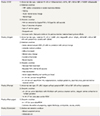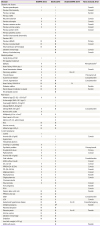1. Hankins GD, Clark SL, Pacheco LD, O'keeffe D, D'alton M, Saade GR. Maternal mortality, near misses, and severe morbidity: lowering rates through designated levels of maternity care. Obstet Gynecol. 2012; 120:929–934.
2. Gortmaker S, Sobol A, Clark C, Walker DK, Geronimus A. The survival of very low-birth weight infants by level of hospital of birth: a population study of perinatal systems in four states. Am J Obstet Gynecol. 1985; 152:517–524.

3. Paneth N, Kiely JL, Wallenstein S, Marcus M, Pakter J, Susser M. Newborn intensive care and neonatal mortality in low-birth-weight infants: a population study. N Engl J Med. 1982; 307:149–155.
5. Arizona Perinatal Regional System (US). Recommendations and guidelines for perinatal and freestanding neonatal care centers in Arizona. 3rd ed. Casa Grande (AZ): Arizona Perinatal Regional System;2012.
7. American College of Obstetricians and Gynecologists and Society for Maternal–Fetal Medicine. Levels of maternal care. Am J Obstet Gynecol. 2015; 212:259–271.
9. Freedman RL, Lucas DN. MBRRACE-UK: saving lives, improving mothers' care - implications for anaesthetists. Int J Obstet Anesth. 2015; 24:161–173.

10. Hasegawa J, Sekizawa A, Tanaka H, Katsuragi S, Osato K, Murakoshi T, et al. Current status of pregnancy-related maternal mortality in Japan: a report from the Maternal Death Exploratory Committee in Japan. BMJ Open. 2016; 6:e010304.

11. Unno N. The perinatal care system in Japan. Japan Med Assoc J. 2011; 54:234–240.
12. Park WS. Development of national patient transfer system for the integrated approach in high-risk mother and infant care. Cheongju: Ministry of Health and Welfare;2015.
13. Lee G. Establishment of health care delivery system between the integrated center for high-risk pregnant women and neonates and the maternity care in the underserved area. Cheongju: Ministry of Health and Welfare;2015.
14. American College of Obstetricians and Gynecologists' Committee on Obstetric Practice. Committee opinion no. 667: hospital-based triage of obstetric patients. Obstet Gynecol. 2016; 128:e16–e19.
15. Wright JD, Herzog TJ, Shah M, Bonanno C, Lewin SN, Cleary K, et al. Regionalization of care for obstetric hemorrhage and its effect on maternal mortality. Obstet Gynecol. 2010; 115:1194–1200.

16. Olive EC, Roberts CL, Algert CS, Morris JM. Placenta praevia: maternal morbidity and place of birth. Aust N Z J Obstet Gynaecol. 2005; 45:499–504.

18. Angelini DJ, Mahlmeister LR. Liability in triage: management of EMTALA regulations and common obstetric risks. J Midwifery Womens Health. 2005; 50:472–478.

22. Xu X, Siefert KA, Jacobson PD, Lori JR, Ransom SB. The impact of malpractice burden on Michigan obstetrician-gynecologists' career satisfaction. Womens Health Issues. 2008; 18:229–237.

23. Xu X, Siefert KA, Jacobson PD, Lori JR, Gueorguieva I, Ransom SB. Malpractice burden, rural location, and discontinuation of obstetric care: a study of obstetric providers in Michigan. J Rural Health. 2009; 25:33–42.

24. Mann S, McKay K, Brown H. The maternal health compact. N Engl J Med. 2017; 376:1304–1305.











 PDF
PDF ePub
ePub Citation
Citation Print
Print



 XML Download
XML Download